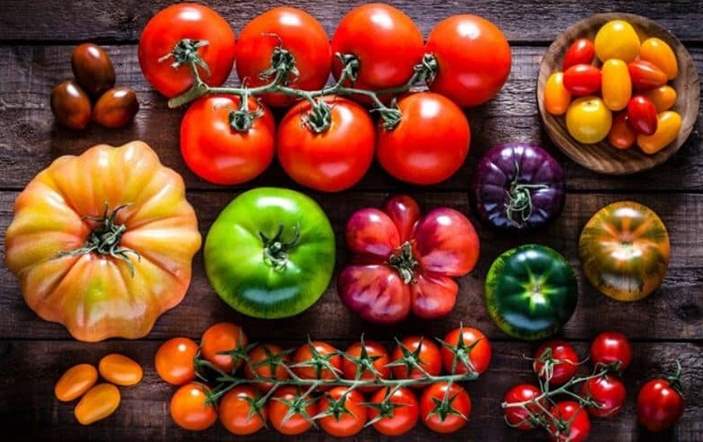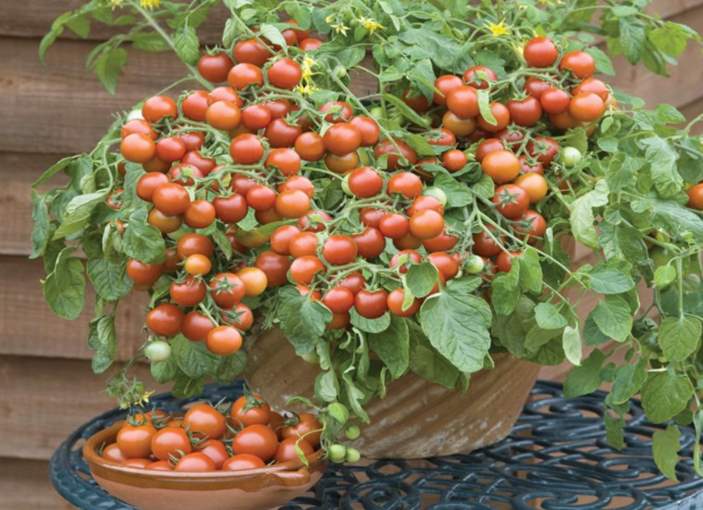Are bunnies allowed to have tomatoes, or is this botanical berry but culinary vegetable harmful? What about the plant (leaves, flowers, or stems)?
Tomato is an edible berry (fruit) from the tomato plant (Solanum lycopersicum) belonging to the family Solanaceae (the nightshade family), which originated from central and South America, among the indigenous Mexicans.

However, in culinary, it is considered as a vegetable and not a fruit together with others like cucumber, green beans, bell peppers, pumpkins, squashes (zucchinis, acorn squash, buttercup squash, etc.), and avocadoes.
You can have tomatoes in raw salads, soup, cooked or stewed, or part of many dishes. You can have them in the form of ketchup, pickles, or juice.
Finally, while most are red, you can find yellow, orange, pink, green, purple, or burgundy tomatoes as well as striped or streaked ones.
Can rabbits eat tomatoes?
Yes. Rabbits can eat tomatoes (only ripe) in moderation as a treat once in a while. Feed them as you do with non-leafy vegetables, i.e., a teaspoon is enough for a rabbit that weighs about two pounds or a thump-tip size of a cherry tomato.
Besides being good for hydration (have 95% water), they have a considerable amount of vitamin C and small amounts of vitamin A, B1, B2, B6, E, and K, as well as a small amount of magnesium, manganese, phosphorus, and potassium.
Also, tomatoes have antioxidants like lycopene (gives them the red color), chlorogenic acid, and beta carotene. It also has naringenin found their skin, which is a potent anti-inflammatory compound (will help reduce inflammations).
Your bunny stand to benefit from all these nutrients and antioxidants may help prevent some cancer types, heart disease, inflammation, arthritis, and so on.
However, rabbits cannot have a lot of tomatoes because they are slightly high in starch, sugars, calories, and they are a bit acidic. Also, they are low in fiber, yet perfect bunny food must have a lot (should be fibrous). Excessive amounts may cause stomach upset, diarrhea, gas, and other problems.
Furthermore, fiber helps not only to wear down a rabbit’s ever-growing teeth via chewing action but also help in promoting a healthy gut and smooth flow (gut motility). Therefore, giving your bunnies a lot of tomatoes isn’t a good idea.
When offering a tomato to your rabbit, go for an organically grown one and remove the fruit stalk since it is poisonous. Don’t give your bunnies a rotten or molded one as they cause stomach upset, diarrhea, gas, and other problems.
Also, wash it thoroughly under running water, cut it into small dices, and offer a slice or two to your rabbit. You can remove the seeds. They may have a tiny amount of solanine or leave them. The amount is too small to cause any serious health risk or choking hazard.
Finally, don’t give tomato to your baby rabbits until they are at least 12 weeks. It is at this age you should begin introducing them.
Can rabbits eat tomato plant or greens – stems and leaves
No. rabbits shouldn’t eat tomato plants (stems, leaves, or flowers), as well as immature green tomatoes. They are high in solanine, a glycoalkaloid poison, as well as tomatine, another milder glycoalkaloid poisons.
These glycoalkaloids offer protection to this plant against fungi, bacteria, insects, or even animals with unripe ones and leaves being very high. If ingested in large amounts, these two glycoalkaloids will harm your furry friend.
Besides being toxic, the leaves and stems also taste bitter, and may bunnies will find them unappealing.
While rabbits tend to avoid onions, garlic, rhubarb, potatoes, leeks, tomatoes, and aromatic herbs, they may nibble them if they don’t have any other choice. Therefore, consider fencing to exclude your bunny or use homemade as well as commercial rabbit deterrents or repellents.
Toxicity signs
Solanine and tomatine are mild poisons that will only present symptoms if your bunny ingests too much of the plant. In such a case, some symptoms they may have include:
- Lethargy
- Loss of appetite
- Drooling
- Breathing difficulties
- Abdominal pain and diarrhea
- Depression, confusion, and behavioral changes
- Weakness
- Paralysis
- Death
If ingested in large amounts, your bunny may show some of these symptoms. Talk to your vet for further diagnosis and treatment.
FAQs
No. As assumed by many people, tomatoes are not high in oxalates, i.e., they are the only in the nightshade family that have moderate amounts of 50mg/100g. These amounts are way low when compared to spinach, which bunnies eat.
Yes. Rabbits can have cherry tomatoes in moderation as a treat. One small one, the size of your thump tip is enough. They are scientifically known as Solanum lycopersicum var. cerasiforme are a variety Solanum lycopersicum, which are smaller in size and have an oblong shape, hence the name plum tomatoes or at times, people call them grape tomatoes due to their small size.
They are usually red with their sizes ranging from the thump tip to a golf ball but, some may be yellow, black, or green.
However, bunnies shouldn’t any part of the cherry tomato plant (leaves, fruit stalk, flowers, or stems since they are also toxic with solanine and tomatine.
Yes. Most bunnies like tomatoes and will enjoy eating it. Even in the wild, they often cause some damage to ripe ones while ignoring leaves and the plants. However, it is good to note that they are not one of their most favored plants or fruits.
No. Don’t give your rabbit ketchup, cooked, pickled, or processed tomatoes. Stick to only a small amount of the raw, fully ripe one. Ketchup has other additives, including preservatives, while cooking degrades their nutritional value and ruins their crunchiness.
What to feed your bunnies?
As you try to bring variety to the foods you give your rabbits, it is a wise idea to stick to the recommended rabbit diet. A typical bunny diet should:
- Have an unlimited amount of grassy hay like timothy, i.e., and it should account for at least 80% of their diet. Only give them some alfalfa hay to nursing, growing, pregnant bunnies, or if you want them to add weight.
- Eat at least 5% high fiber pellets to help balance their diets. Pellets are fortified with minerals to prevent any deficiencies.
- Also, include 10-15% fresh foods to provide vital phytochemicals, extra vitamins, and other nutrients. Of the fresh food, leafy greens or veggies should account for about 75% of all the fresh foods.
- Up to 5% fresh treats. Treats will include non-leafy veggies like tomatoes, carrots, zucchinis, cucumbers, and so on, herbs, flowers, fruits, and commercial bunny treats.
- Always have Unlimited access to fresh, cool water.
Tomato alternatives?
Some of the best options include non-leafy veggies or fruits. Give your bunnies the following:
- Carrot
- Zucchinis
- Cucumbers
- Apples without core or pits
- Watermelons
- Celery stems
- Turnips
- Chicory root
- Celeriac
- Baby sweetcorn
- Kiwis
- Peaches
- Papaya
- Pineapples
The list is endless. Just ensure rabbits have these alternatives as an occasional treat and keep varying them to provide maximum nutritional benefits and minimize monotony.
